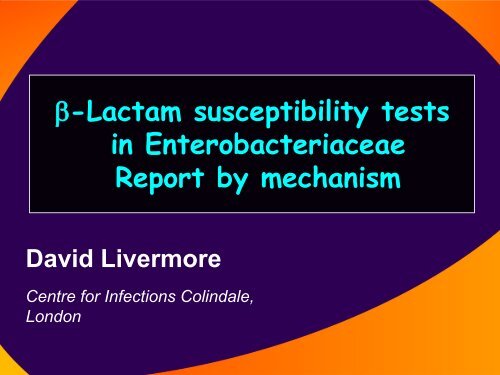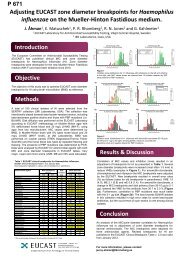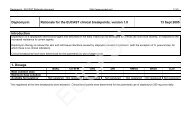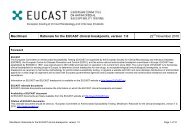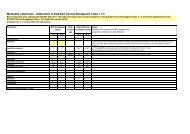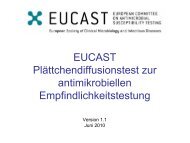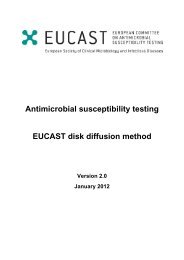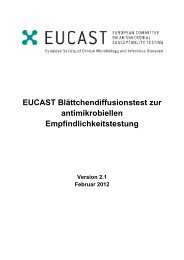David Livermore - eucast
David Livermore - eucast
David Livermore - eucast
Create successful ePaper yourself
Turn your PDF publications into a flip-book with our unique Google optimized e-Paper software.
-Lactam susceptibility testsAcademic Perspective inEmerging Issues of Resistancein Gram-ve Bacteriain EnterobacteriaceaeReport by mechanism<strong>David</strong> <strong>Livermore</strong>Centre for Infections Colindale,London
ESBLs matter…14-mortality ESBL Klebsiella bacteraemiaCarbapenem R x 2/10No carbapenem 40/61P .0121Paterson et al. CID 2004, 39, 31
Mortality in ESBL vs. non-ESBLEnterobacteriaceae bacteraemiaSchwaber & Carmeli JAC 2007 60:913
Outcome & MIC bacteraemias withESBL-KlebsiellaPatient Source Ceph MIC (mg/L OutcomeM72 VAP Ceftazidime 16 FailM76 Central line Ceftriaxone 16 FailM58 HAP Ceftriaxone 12 Fail, died @ 48hM39 Central line Ceftriaxone 8 Fail, died @48hF35 Surg wound Cefotaxime 4 FailM48 Unknown Cefepime 2 FailM49 Peritonitis Ceftriaxone 1.5 CureF73 VAP Cefepime 1.5 CureM25 VAP Cefepime 0.5 Fail, died septicF25 Central line Ceftazidime 0.5 CurePaterson et al., J Clin Microbiol 2001; 39: 2206
Outcome & MIC in bacteraemias withCTX-M-3/-14 E. coli; ceftazidime 2g q8hPatient Source MIC (mg/L OutcomeM62 UTI 8 CureF49 Peritonitis 1 Responded, butdrainage neededF36 UTI 2 CureM45 Biliary infection 2 CureM67 ? 2 CureF76 HAP 8 CureF38 UTI 0.5 CureBinet al., DMID 2006; 56: 351
Look directly for ESBL Klebsiella--Where it beganUTI Ceph 2 2Non-UTICeph+aminoglycosideCeph+aminoglycosideMIC moden Cure Fail Relapse2 23 2 1RangeCefotaxime 2 0.5-4Ceftriaxone 2 0.5-4Ceftazidime 4 1-16Brun-Buisson et al Lancet 1987; ii: 302
Ceftazidime MICs for Enterobacteriawith CTX-M-9/14 ESBLs
First point…..It’s not so clear that cephalosporin MICs of 1-4 mg/L are associated with satisfactoryoutcomes….Second point…The lab doesn’t determinemeasure MICs anyway
E. coli NCTC13352. K-12 derivativewith TEM-10, a ceftazidimaseMIC mg/LCeftazidime >128Cefotaxime 1-2Ceftriaxone 1-2Cefepime 2-44 labs each did disc tests 10 times…
NCTC13352: Unedited results forceftazidime 30 mg discs: 10 tests/labMeanzone (mm)SD(mm)S>30I26-29R
NCTC13352: Unedited results forcefotaxime 30 mg discs: 10 tests/labMeanzone (mm)SD(mm)S>30I24-29R
NCTC13352: Unedited results forcefepime 30 mg discs: 10 tests/labMeanzone (mm)SD(mm)S>32I27-31R
Third (& Say it in whispers…)For the seriously-ill patient, fast microbiologyis more valuable than precise microbiology…And, mostly, microbiology moves at the paceit did in Fleming’s time: 48h from specimento susceptibility resultLooking for mechanism can be faster….
Mortality in ESBL vs. non-ESBLEnterobacteriaceae bacteraemiaSchwaber & Carmeli JAC 2007 60:913
Delay in appropriate R x ESBL vs.non-ESBL Enteric bacteraemiaSchwaber & Carmeli JAC 2007 60:913
ChromID ESBL (bioMerieux)• Selective agar withmultiple antibioticsincluding cefpodoximeE. coli pink –K. pneumoniae greenP. mirabilis brown• Rapid detection ofcommon ESBL+enterobacteria within18-24h of specimen
Chromogenic media to detectESBL producers- 765 specimensChromID ESBL(bioMerieux)True+False+False-SensitivityPPV29 46 4 88% 38%BLSE (AES)* 28 154 5 85% 15%ChromID : proprietary, cefpodoxime basedBLSE : 2 compartments : Drigalski agar + cefotaxime, 1.5 mg/LMacConkey + 2 mg/L ceftazidimeReglier-Poupet et al. JMM 2008; 57, 310
Cica b-Test (Mast)•Examine hydrolysis of chromogenic oxyiminoceph, HMRZ-86- yellow to red• If +ve, test inhibition IN SEQUENCE by:‣Sodium mercaptoacetic acid – MBL‣Clavulanic acid – Class A / ESBL‣Benzo-thiophene-2-boronic acid – AmpC• Count first positive result
Cica b-Test (Mast) blind testingof overnight culturesReference dataMechanism inferredMBL ESBL AmpC MixedOtherPen’aseNoactivityMBL (26) 20 1 0 2 3 0ESBL (74) 3 63 2 6 0 0AmpC (25) 2 0 18 3 2 0K. oxytoca, K1 (10) 0 2 6 2 0 0OXA carbapenemases (10) 0 0 0 10 0 0P. aeruginosa OXA ESBLs (4) 1 3 0 0 0 0KPC/SME carbapenemase (2)0 0 2 0 0 0Penicillinase (39) 5 3 1 0 30 0Better but slower to use with antibiogram @ 48h<strong>Livermore</strong> et al., JAC in press.
Fast molecular detection ofresistance• PCR or gene chip technology on overnight culture...or directly from specimen• Identify gene and predict resistance– But not MIC / direct measure of susceptibility• Would be available if all ESBLs were bla CTX-M variants– Has been slow for ESBLs because many are sequencevariants of bla TEM/SHV• Feasible for carbapenemase genes
Carbapenem R x in infectionswith KPC KlebsiellaPatient Site MIC imipenem Days OutcomeVitek EtestimipenemM76 Respiratory 2 0.25 7-mero FailedM82 Blood 4 2 14 CureM92 Respiratory 4 2 3 CureF64 Respiratory 4 2 12 FailedF69 Respiratory 4 8 6 FailedF46 Blood 4 8 7 CureM77 Respiratory 4 >32 7 FailedF61 UTI 2 >32 7 CureM52 UTI 4 16 14 FailedF60 Blood >16 8 10-mero FailedM60 Respiratory >16 8 7-mero CureWeisenberg et al., DMID 2009;64:233
Which is more useful?48 h post-specimen‘It’s a Kleb. pneumoniae. Very resistant. We’ve found anMIC of 4 mg/L for meropenem, though. It might be okay athigh dose. Or prolonged infusion. Otherwise there’s colistin.’‘Yes of course; our lab is fully accredited!’4 h post-specimen‘There is something with a KPC gene in this sputum from MrX with the ventilator pneumonia’‘It’s likely to be resistant to everything except colistin’
Fourth point: only by beingalert do you spot the unusual1 2 3 4Cefpodoxime 128 8 128 8….+clavulanate 1 2 32 4Ceftazidime 16 1 64 2….+ clavulanate 0.25 1 32 2Cefotaxime 128 0.5 64 0.5….+ clavulanate 0.03 0.5 32 0.5….+ cloxacillin 64 0.5 2 0.5Cefepime 32 0.5 2 4….+ clavulanate 0.03 0.5 1 2Ertapenem 0.06 0.25 0.5 4Meropenem 0.03 0.06 0.03 1
Last....ECCMID 2010Official symposia:• 2 with ESBL in title• 1 on carbapenemases• 1 on b-lactamase inhibition• 1 on low level resistance• & this one!Are you really going to tell me that the mechanismdoesn’t matter, just the (not very exact) MIC or zone?
Report by mechanism• Ceph MICs of1-2 mg/L don’t consistently predict response• Routine tests not exact enough for pD interpretation• Finding the mechanism can be faster than finding the MIC‣ Early appropriate treatment saves lives• Thinking mechanisms enables the unusual to be spotted‣ Sometimes something new– OXA-48• Epidemiologically and clinically important‣ Or ECCMID committee has the programme wrong?


